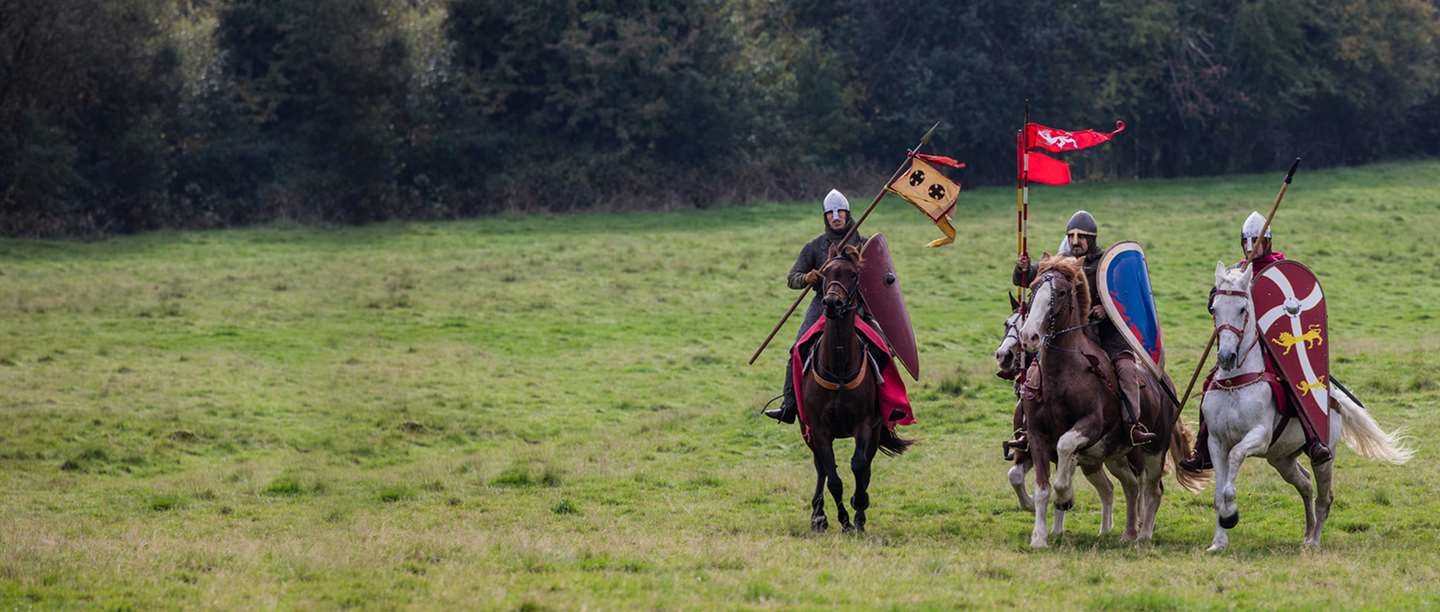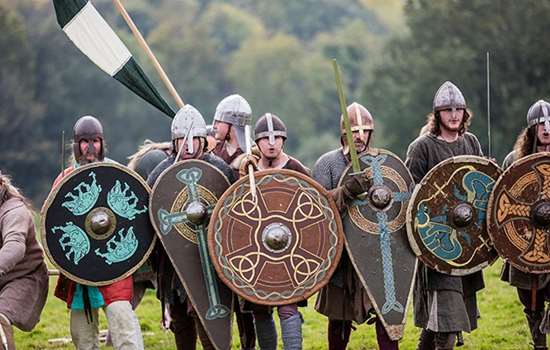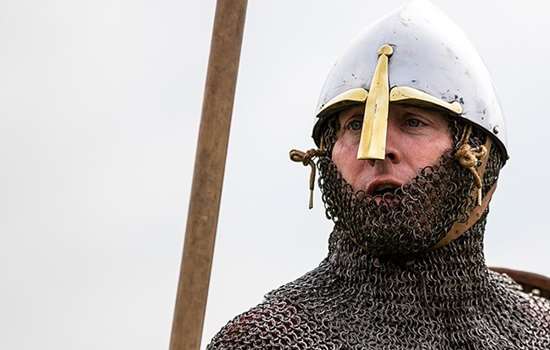The Battle-Axe
At the Battle of Hastings, the most fearsome Anglo-Saxon warriors were King Harold's 'housecarls' - his private army of highly trained professional fighters and bodyguards. These were among the finest soldiers in Europe.
Their favourite weapon was a mighty long-handed battle-axe, also called a 'Danish axe' because it had originated with the Vikings. Swung with two hands, the battle-axe was capable of cutting off the head of a man or horse. But it was also light and well-balanced enough to be used with one hand, while the other held a shield.
The Bow
Many Norman archers are shown in the Bayeux Tapestry, and it's estimated that there were over 1,000 of them in William's army. They played an important part in the battle, especially after William ordered them to shoot high, firing their arrows onto the heads of the Saxons behind their shield-wall.
Archers needed to move quickly, so they were lightly clothed and sometimes barefoot and bare-legged. Some are shown carrying their arrows in 'quivers' attached to their belts, while others take theirs from bigger quivers placed on the ground.
Though none are shown in the Tapestry, the Norman army also included crossbowmen. Crossbows, a relatively new kind of weapon in 1066, shot much more slowly than ordinary bows, but their 'bolts' could penetrate right through shields.
Only one Anglo-Saxon archer is shown in the Tapestry, symbolising that Harold's army included very few bowmen. Archers were poor men, and it's possible they couldn't afford horses to help them keep up with Harold's rapid move to the battlefield.
The Spear
Used by both sides at Hastings, the iron-headed spear was the poorer warriors' weapon. It could be used for thrusting, or thrown like a javelin. In the Bayeux Tapestry, some Saxons are shown holding bundles of spears ready for throwing.
Want to know more? Watch our video and join Archaeological Ironworker Hector Cole MBE as he forges a spearhead from the 1066 era.
The Lance
Most Norman knights carried long spears called lances. These could be tucked under the armpit like a later jousting lance, but are more often shown being held in the right hand and wielded overarm. Knights used them to thrust through gaps in the Saxon shield-wall or spear fleeing enemies, and they could also be thrown.
The Shield
Several different shield shapes are shown on the Bayeux Tapestry. The long kite-shaped shield, typical of Norman knights but also carried by Norman foot-soldiers, protected the whole body. It could be slung round the neck on a strap or carried on the left forearm when riding, leaving the left hand free for the reins. It also had hand-grips to hold it when fighting on foot.
Some Saxons, especially the 'housecarls', also defended themselves with kite-shaped shields. But others used stronger and heavier round wooden shields. Both types could be interlocked together to form a 'shield wall'.
Round shields had spiked metal 'bosses' in the middle. So they could also be used as weapons, to injure an enemy or push him off-balance, making the shield a deadly weapon as well as a defensive instrument.
The Sword
Both Anglo-Saxons and Normans used swords at the Battle of Hastings. They were of simple design, with a cross-guard to protect the hand and a broad two-edged blade with a shallow point. But they varied greatly in quality, from the plain iron-bladed swords used by poorer warriors to the finely-made steel-bladed weapons treasured by great men. These were passed down in families and many were given names - one Viking king's sword was called 'Legbiter'.
1066 swords were used more for slashing than for thrusting. A really good sword could cut through a shield or even armour, and in the Bayeux Tapestry a Norman knight is shown slicing off the head of a Saxon battle-axe with his sword.
The Knight
Knights, armoured warriors fighting on horseback with lance, sword and shield, were the Norman 'secret weapon' at the Battle of Hastings. Nothing like them had been seen in England before. For though the Saxons rode to battle or on journeys, they always fought on foot.
There were between 1,000 and 2,000 knights in the Norman army, and it was these who mainly won William's victory.
Norman knights were trained from childhood to fight on horseback. Known as 'destriers' and often stallions, their warhorses were bred to carry armoured men. These fierce horses also fought for themselves, biting opponents or lashing out with their hooves.
The 1066 Norman army included many groups of knights who were used to fighting side by side under the same leaders. So they stuck together when doing difficult things like pretending to flee, but then turning and cutting down their Saxon pursuers.
The Mace or Club
Wooden clubs, perhaps studded with iron nails, were cheap weapons that everyone could afford. But in the Bayeux Tapestry both William the Conqueror himself and his half-brother Odo of Bayeux are also shown carrying club-like 'maces', perhaps a badge of rank. Maces were used for hitting enemies over the head, and could also be thrown.
More About 1066
Discover how the Norman Conquest transformed England, and explore some of the spectacular castles and great abbeys the Normans built across the land.


